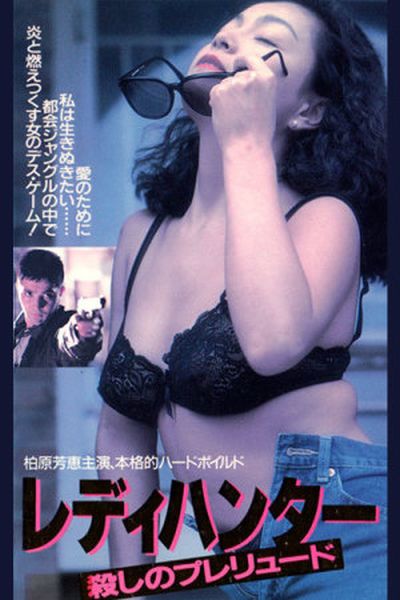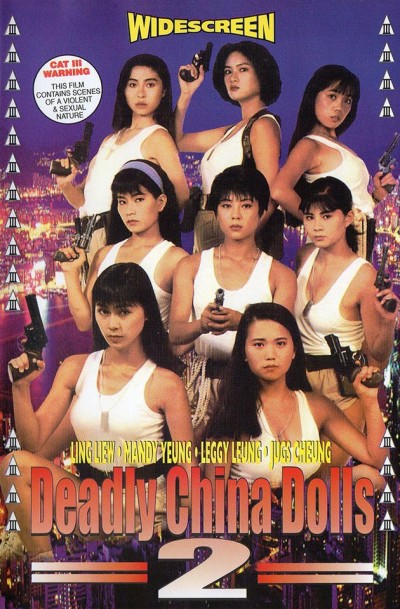★★½
“Taking the Miike”
 While not the first to be released, this was the first movie directed by Miike, who would go on to become one of the most prolific – yet, still, critically-lauded – directors to come out of Japan in the last quarter-century. Perhaps this is well-informed hindsight: yet, if still pretty basic in its content, it does feels at least somewhat above what you would expect from a straight-to-video movie by a first-time director.
While not the first to be released, this was the first movie directed by Miike, who would go on to become one of the most prolific – yet, still, critically-lauded – directors to come out of Japan in the last quarter-century. Perhaps this is well-informed hindsight: yet, if still pretty basic in its content, it does feels at least somewhat above what you would expect from a straight-to-video movie by a first-time director.
Saeko (Kashiwabara) is a retired soldier, living quietly in the city – though not without a touch of PTSD, if her bunker-like apartment is any indication. A former colleague, now running a day-care, calls on Saeko for help after an abduction attempt on one of the kids he’s looking after, whose mother has also gone missing. Those behind the abduction turn their attention to Saeko, only to find out they’ve bitten off rather more than they can chew in the former special forces operative, who has a very particular set of skills, as they say… She’s intent on getting to the bottom of things.
Despite the salacious cover, this is actually relatively tame in terms of content. The only nod to prurience is perhaps when Saeko knocks out and ties up a female opponent, it’s with an elaborate series of knots, which appear to have strayed in from a Japanese bondage film. Overall, it’s better at the set-up than the execution, especially in the second half, when the action takes a back seat – not least to scenes involving technology that have not aged well. Though nor was the print I saw helped, by English subs which seemed to pop out to the bathroom for much of the time.
Initially, I was wondering whether the bulk of the film was going to be a siege on the heroine’s apartment – an idea which Everly subsequently utilized. That could have been a nice way of exploiting the limitation of a small budget, with a claustrophobic setting, turning Saeko into an urban version of Rambo, making the most of her environment. Shame she (and the film) eventually escape, as it’s close to the best part of the movie, and loses a significant amount of steam thereafter. The other memorable sequence introduces Eddie, another former colleague of Saeko’s, who tells a brutal war story to two drunken Japanese women, who laugh hysterically throughout it: the ending has an unexpected, disturbing twist.
Indeed, that applies to the film overall – the final scene perhaps sticks in the mind significantly more than it makes narrative sense. It turns out the kid is the offspring of some high-ranking guy from Moldova (the term “king” is used in the subs; I suspect something was lost in translation there); quite what’s going on remains not entirely clear. Dating from 1991, it feels a little like a precursor of the Zero Woman series from later in the decade. In the light of what Miike would go on to do, it’s something of a interesting curio. But to be honest, if anyone else had directed this, it would likely have been condemned to the memory hole of cinematic history.
Dir: Takashi Miike
Star: Yoshie Kashiwabara, Naomi Morinaga, Kōsuke Morita, Isao Murata
a.k.a. Red Hunter: Prelude to Kill





 This is confusing. For the IMDb
This is confusing. For the IMDb  A meteor crashes into Tokyo Bay, creating a cloud of “cosmo-amphetamine” that infects everyone in the area. When they die, that drug immediately takes over, bringing them back to life as flesh-eating zombies. Colonel Kirihara is leading the rescue mission, and sends his daughter, K-ko (Suzuki) into the contaminated zone to scope things out. She finds that one of his underling, Captain Fujioka, is using the chaos to carry out human experiments, deliberately infecting survivors with the cosmo-amphetamine, in order to turn them into an unstoppable force of undead soldiers. He’s not willing to let anyone get out alive, least of all K-ko. Fortunately, her father gave her a battle suit, which helps to even the odds against the living dead army she faces.
A meteor crashes into Tokyo Bay, creating a cloud of “cosmo-amphetamine” that infects everyone in the area. When they die, that drug immediately takes over, bringing them back to life as flesh-eating zombies. Colonel Kirihara is leading the rescue mission, and sends his daughter, K-ko (Suzuki) into the contaminated zone to scope things out. She finds that one of his underling, Captain Fujioka, is using the chaos to carry out human experiments, deliberately infecting survivors with the cosmo-amphetamine, in order to turn them into an unstoppable force of undead soldiers. He’s not willing to let anyone get out alive, least of all K-ko. Fortunately, her father gave her a battle suit, which helps to even the odds against the living dead army she faces.